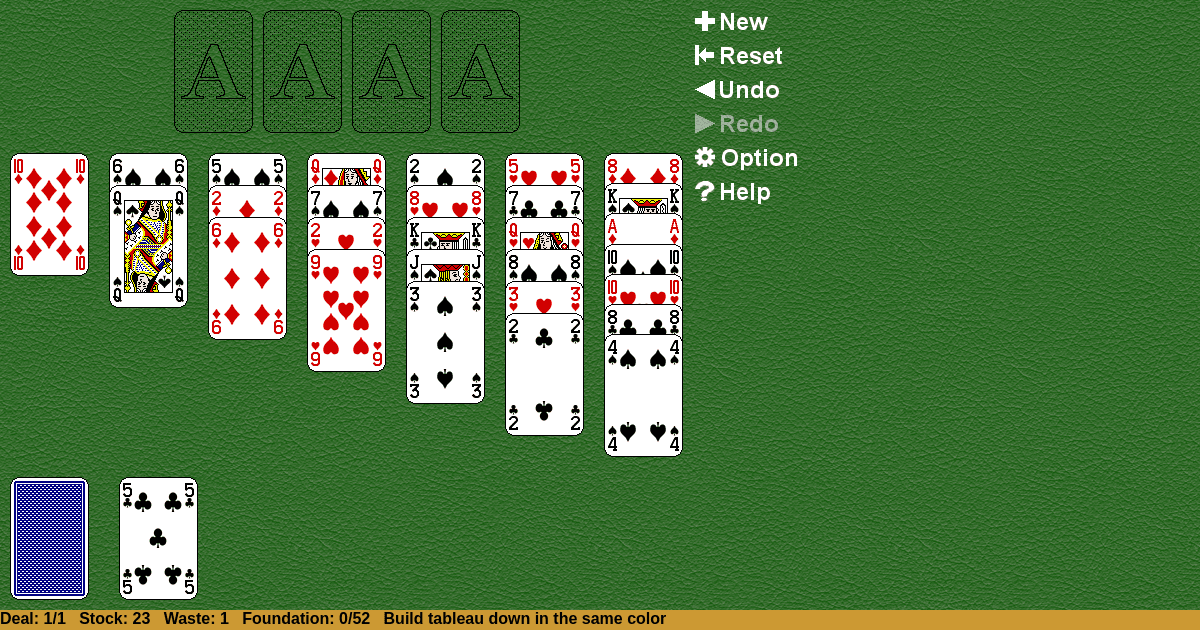Whitehead
Home |
How to play |
FAQ |
About
How to play Whitehead?
Game Objective:
The primary goal in Whitehead Solitaire is to move all cards from the tableau and stock to the four foundation piles, building each foundation up in suit from Ace through King.
Setup & Layout:
- Deck: Uses a standard 52-card deck.
- Tableau: Seven tableau piles are arranged left to right. The first tableau pile receives one card, the second gets two, continuing up to the seventh pile, which receives seven cards. All tableau cards are dealt face-up.
- Foundations: Four foundation piles, initially empty, are placed above the tableau.
- Stock: The remaining 24 cards form the stock, placed face down.
- Waste: One waste pile is used to hold cards dealt from the stock.
- Key Play Areas Defined:
- Tableau: The main play area where cards are arranged in descending sequences by color.
- Foundations: The destination piles for building up each suit from Ace to King.
- Stock: The draw pile for additional cards.
- Waste: Receives cards dealt from the stock, with only the top card available for play.
Whitehead Solitaire Rules:
Foundations:
Only Aces may be moved to empty foundation piles.
Foundations build up by suit in ascending order (Ace, 2, 3, …, King).
Once a card is placed on a foundation, it cannot be removed.
Tableau:
Tableau piles build down by color (red on red, black on black), not by alternating colors.
For example, a 9♦ or 9♥ may be placed on a 10♦ or 10♥; a 9♠ or 9♣ may be placed on a 10♠ or 10♣.
Only sequences built down in the same suit may be moved as a group between tableau piles.
Any card may be moved to an empty tableau pile. Some sources specify only Kings or sequences starting with a King may fill empty spaces, but the majority of modern implementations allow any card or valid sequence.
Stock & Waste:
The stock deals one card at a time face-up to the waste.
Only one pass through the stock is allowed; there are no redeals.
The top card of the waste pile is available for play to the tableau or foundations.
Gameplay:
- On each turn, a player may:
- Move the top card of any tableau or the waste to a foundation if it is the next card in sequence and suit.
- Build cards down by color on the tableau, moving single cards or entire in-suit sequences.
- Move any available card or valid sequence to an empty tableau pile.
- Deal one card from the stock to the waste when no other moves are available or desired.
- Only the top card of each tableau pile and the waste is available for play.
- Play continues until all cards are moved to the foundations or no further legal moves are possible and the stock is exhausted.
Winning & Losing Conditions:
- Win: The game is won when all 52 cards are successfully built onto the four foundations in ascending order by suit, from Ace to King.
- Lose/Unwinnable: The game is lost if no further legal moves are possible and the stock is depleted, with cards remaining in the tableau or waste.
Special Rules & Edge Cases:
- Filling Empty Tableau Spaces:
- Any card or valid packed sequence may fill an empty tableau pile. Some sources note that only Kings or sequences starting with a King may fill spaces, but the prevailing rule allows any card.
- Moving Sequences:
- Only sequences built down in the same suit (e.g., 10♠, 9♠, 8♠) may be moved together as a group between tableau piles.
- Sequences built down by color but not in the same suit cannot be moved as a group; only individual cards may be moved in such cases.
- No Redeals:
- There is only a single pass through the stock; once the stock is empty, no more cards can be dealt.
- Foundations are Final:
- Cards placed on the foundations cannot be removed or played back to the tableau.
- Waste Pile:
- Only the top card of the waste pile is available for play; cards beneath it are inaccessible until the top card is moved.
Note: Some minor rule variations exist between sources, especially regarding which cards may fill empty tableau spaces. The most widely accepted modern rule is that any card or valid sequence may fill an empty tableau pile. If playing with stricter rules (as in some older sources), only Kings or King-led sequences may fill empty spaces. Always confirm the house rules before play.




























































